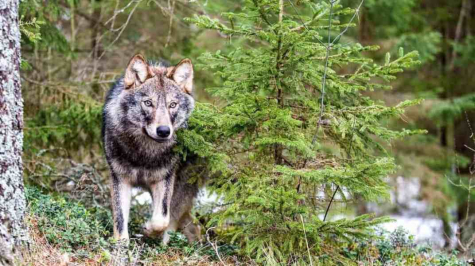For forest owners , the control of wild herbivore populations by predators is helpful.
Photo: Sergei Gorškov, https://wilderness-society.org
Estonian text posted by the Team of the Animal of the Year 03.02.2019
English translation Google Translate
The utility of large carnivores for the entire ecosystem is quite clear to all. For humans, predators are generally still considered a problem. However, a study published by Australian and US scientists in Nature Ecology & Evolution in 2018 was specifically dedicated to pointing out the benefits that humans receive from the presence of wild predators.
The article deals with predators at the highest level of the trophic chain from birds of prey to large felines. Wolves are also recognized for multiple beneficial contributions. For example, it is known that more than one million traffic accidents occur each year in the US due to collisions with wild herbivorous animals. 200 people lose their lives in these accidents.
In Europe, matters are not better. In Germany alone, there are more than 250,000 such accidents per year. Wolves, by limiting the number of large herbivores, help to significantly reduce the incidences. Also in Estonia the roe deer is a much more dangerous animal than any wild predator in terms of injuries and deaths from traffic accidents that it causes. Predators and scavengers help to keep the ecosystem clean. Here also the role of a new actor in the Estonian forests, the jackal, must be recognized. For example, in Europe, jackals annually remove more than 13,000 tonnes of animal remains (including animals killed by traffic). Other predators also contribute to the cleaning work. Predators limit the spread of many diseases. For example Slovak studies show that only 7% of outbreaks of classical swine fever occurred in territories inhabited by wolf packs. Wolves prefer to attack weak and sick boars, and so they have achieved better results than human intervention in preventing the spread of disease in many areas. Something for which the pig breeders have had reasons to be grateful. It is known that, although Australian dingoes sometimes attack sheep, they have a more positive than negative effect on Australian sheep breeding. The dingoes feed heavily on kangaroos, which in turn compete with cattle for grazing. By limiting the abundance of kangaroos, dingoes allow sheep and cows to have more food.
The result is an increase in milk and meat production and, therefore, economic benefits for farmers. This gave the authors reason to believe that the wolf and the lynx in Europe could also have an indirect positive effect for sheep farmers due to the limitations of the number of roe deer. Especially when the cattle are well protected and the direct damage from the predators is minimized. However, roe deer do not consume as much grass as kangaroos. Specific research is needed to prove or disprove the potential benefits of wolves and lynxes for cattle farmers. So far, however, we can be happy that predators that limit the number of herbivorous animals, at least for forest owners are very helpful. Therefore, in addition to adding the continuous economic losses, it would be useful to also observe the positive impact of predators on human health and well-being. However, for predators to be beneficial both for us and the forest, their abundance must be ecologically effective, not only minimal for the population to survive. An English language review with links to various research activities can be found here
Laura Kiiroja



